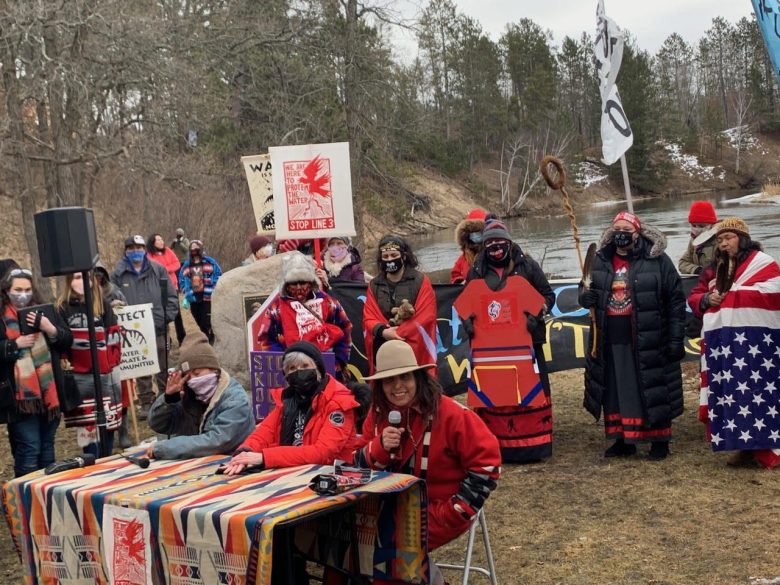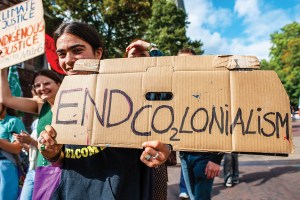The Ojibwe, who are fighting a massive assault on their ancestral territory, are on tenterhooks waiting for a White House decision that could forever change their lands and lives.
 From left Tara Houska, Jane Fonda and Winona LaDuke speak at a press conference in Menahga, Minnesota. [Courtesy of Barbara Williams]
From left Tara Houska, Jane Fonda and Winona LaDuke speak at a press conference in Menahga, Minnesota. [Courtesy of Barbara Williams]
The word “Minnesota” derives from one of two Dakota words, either Mni Sóta meaning clear blue water or Mnissota meaning cloudy water. Just one letter can change the entire meaning. Just one oil spill could ruin the entire ecosystem. I traveled to Northern Minnesota with Jane Fonda and Tessa Wick last month to stand with the Ojibwe who are fighting a massive assault on their ancestral territory. Line 3 is a pipeline that was built in 1950 and currently has 900 structural problems according to Enbridge, the Canadian company that owns it. Under the guise of replacing it, Enbridge is in fact abandoning the old one and aggressively laying the infrastructure to expand it into a larger pipeline with greater capacity.
The proposed monstrosity would snake through 200 pristine lakes and rivers in Northern Minnesota including watersheds for the wild rice that is unique to this part of the world and has been intrinsic to the Anishinaabeg/Ojibwe way of life for centuries. A spill could permanently destroy rice beds as well as the fish and wildlife habitat. Enbridge has had over 800 spills in the last 15 years, most notably the largest inland oil spill in U.S history when 1.2 million gallons leaked into the Kalamazoo river in 2010. A spill is inevitable.
During his lame duck period, Donald Trump approved Line 3, in spite of no Environmental Impact Study. It is currently under review. Now that justice has been rendered in the George Floyd case, there is hope that Minnesota Attorney General Keith Ellison will turn his attention to the social and environmental injustice of Line 3. President Biden should overturn the Army Corp’s permit to Enbridge as he did with the Keystone XL pipeline.
Our first stop was at a compound on the White Earth Reservation. It houses 8th Fire Solar, a facility where tribal members are building thermal solar panels. It is the headquarters for Honor the Earth, an organization founded by Winona LaDuke, with the mission of creating awareness and support for Native Environmental issues.
Winona is a magnetic and fiery leader who has long been a vital force protecting the earth. In addition to harvesting wild rice (manoomin) and building solar panels, Winona runs a fledgling hemp business, taps maple trees, and has ventured into small batch coffee roasting. The people on the White Earth reservation are making every effort to be self-sufficient through sustainable activities.
We were served delicious buffalo egg rolls while the Women Water Protectors shared stories of getting roughed up by the local police for protesting the pipeline. They were strip searched and kept in over-crowded cells – in the time of COVID. The Public Utilities Commission has created an Enbridge funded account to pay for policing Enbridge opponents – meaning they are paid more when they harass and arrest activists.
When we were convoying to a press conference the two women driving in front of us were pulled over for not signaling 100 feet before turning. Fortunately they were both constitutional lawyers – and white I might add. After delaying them for 15 minutes, the officer realized what she was up against and backed down.
On the banks of the Crow Wing River, against a backdrop of Ojibwe Grandmothers in traditional garb, Jane and Winona shared a panel with Tara Houska, an Ojibwe, Yale educated Tribal lawyer who hung up her suit in DC to come back and live with other Water Protectors on a 70-acre resistance camp called the Giniw Collective.
Jane’s presence had brought out a slew of media. She has become the wise woman educating and inspiring her vast network of old and new fans. She speaks knowledgably on the salient issues surrounding climate change. She emphasizes the importance of good paying jobs being in place as we transition from fossil fuels to sustainable energy. She mentions a statement Winona made about a moment when we had the choice to have a carbohydrate history or a hydro-carbon history and we chose the wrong one. “It’s time to correct that.”
Tara explains the illegitimacy of Line 3 being built on public lands. She has joined the charge of young activists fed up with ineffectual political policy and are using their bodies and agency to say “No More.” Winona quotes Arundati Roy, urging us to see the “Pandemic as Portal.” We must go through the portal leaving dead ideas behind, ready to imagine a new world.”
Video by Honor the Earth (honorearth.org)
The crowd is energized, everybody is wearing red. There is a festive feeling of optimism in the air. At key points a giant black bear puppet roars with approval or grunts with displeasure. Indigenous Drummers drum. River otters play. Four years ago I accompanied Jane on a fly-over of the Canadian Tar Sands in Fort McMurray Alberta, source of the dirty oil Enbridge exports. From the air the open pit mines made me think of cancer sores with the outgoing vessels bringing disease to the rest of the body.
The jobs pay well. It’s how my sister and her husband bought their home. Workers go where the money is. But it’s a dying industry. Justin Trudeau enthusiastically signed on to the Paris Climate Accord and vowed to invest in renewable energy sources but he’s bowed to the corporate powers who are squeezing out every ounce of filthy lucre from the Tar Sands before they collapse. Not only is tar sand extraction the dirtiest and most inefficient process, it’s the most uneconomical. If the government took the bold step of subsidizing other sectors of the economy such as renewables, housing and transportation, to the degree they subsidize the tar sands, it would be far more beneficial to the economy and people’s lives – in the long run. But they are short-sighted.
Image: Dan Feidt
The fish and wild life that the Métis First Nations of the Athabaska region have traditionally subsisted on are riddled with deformities and tumors. Eighty-seven percent of the community believes the Tar Sands are responsible. We sat with Cece, who was a heavy equipment operator for 7 years. At 60 years old she had outlived all her co-workers, including her husband who died of cancer the year before. She ran for Tribal Chief on a platform of pushing for stricter tar sands regulations but the industry bribed her opponent with the promise of a senior care facility if he would show his support. She lost by one vote. Divide and conquer, the age-old tactic of domination.
With Line 3, Enbridge does not want to repeat the clashes they encountered at Standing Rock so they have pumped money into targeted communities. The chronic neglect of government on the reservations, exacerbated by the economic downturn from the pandemic has served to Enbridge’s advantage. People need to feed their families and Enbridge is there with the jobs. Enbridge created a trust from which the Fond Du Lac tribal government doles out monthly payments to their members. It’s a terrible dilemma for individuals who fear reprisal if they express opposition. The project has created deep divisions within the Indigenous community but the vast majority are fervently against it.
With people coming to work from all over the country, the Enbridge man camps are potential COVID super-spreaders. According to the Violence Intervention Project in Thief River Falls, at least two women have been sexually assaulted. Numerous women say they have been harassed by pipeline workers and do not feel safe. Two Enbridge employees based in Wisconsin were recently arrested for sex trafficking.
Jane did a skyped interview with Lawrence O’Donnell on MSNBC. In a breathtaking 6 and a half minute uninterrupted spiel she laid out the micro and the macro of the entire situation. Later she worried it might have come across as manic. No, Tessa and I assured her, it came across as urgent.
After a long drive, Tara led us down a narrow, snow covered dirt road to a small encampment of tents where they are sugaring the maple trees. Sap is collected and continuously poured into a gigantic hand-hewn pot mounted over an open fire, then reduced down for several days. It’s very labor intensive – the ratio is 26 gallons of sap to make one gallon of syrup. They are not selling the syrup, they want to hold on to it in case there’s a shortage or some other catastrophe occurs. They’re holding on to their wild rice too. Everyone is on tenterhooks waiting for a decision from the White House. Their future hangs in the balance.
10 Comments
Comments are closed.

 From left Tara Houska, Jane Fonda and Winona LaDuke speak at a press conference in Menahga, Minnesota. [Courtesy of Barbara Williams]
From left Tara Houska, Jane Fonda and Winona LaDuke speak at a press conference in Menahga, Minnesota. [Courtesy of Barbara Williams]

Expenditures for law enforcement under PUC Enbridge deal:
Enbridge so far has paid about $750,000 to Minnesota law enforcement agencies for policing the construction of its controversial new oil pipeline.
The money has covered officers’ wages, police equipment and training, including for crowd control, according to information filed with the state. Enbridge will likely spend a lot more before the half-built replacement for its corroding Line 3 is finished.
Enbridge’s support of the public-safety fund is mandated as part of Minnesota utility regulators’ approval of the $3 billion-plus pipeline. The rationale: make the Canadian company pay for Line 3-related law enforcement costs — not Minnesota taxpayers.
But some legal experts said the fund raises sticky questions about the line between public law enforcement and private-security needs.
“I don’t want to make any claims that this is a good thing or a bad thing, but it is a fraught thing,” said Henry Blair, a professor at Mitchell Hamline School of Law in St. Paul. “The question at the grand level is, does private-party money going toward a government function impact the way police are prioritizing their obligations? Are police occupying that neutral position we want them to be occupying?”
Protesters say they are not.
“You have a foreign company funding the police in northern Minnesota and incentivizing the repression of citizens,” said Winona LaDuke, head of Honor the Earth, a Minnesota-based Indigenous environmental group. “They basically have taken your police force and turned it into their security force.”
Sheriffs bristle at such a contention.
“It’s not about Enbridge, and it’s not about protecting them,” said James Tadman, sheriff of Polk County, one of 13 counties that hosts the current Line 3. “People have the right to protest and they have the right to be heard. But once there is a complaint called in — damage to property, trespass — I have to deal with that. … I don’t get paid by Enbridge.”
Enbridge feeds fund
Enbridge’s new 340-mile pipeline across northern Minnesota has been a lightning rod since it was proposed in 2014.
Environmental groups and some Ojibwe bands have slammed it, saying its route opens a new region of Minnesota rivers, lakes and wild rice waters to oil spills, as well as exacerbating climate change.
Enbridge said the new pipeline, which will ferry Canadian oil to the company’s terminal in Superior, Wis., is a big safety upgrade. The company began construction in December after receiving final regulatory approvals.
Protests began shortly thereafter. They have been centered so far in three areas along the pipeline route: Hubbard County, near Park Rapids; Carlton County on the Fond du Lac Reservation; and Aitkin County near the Mississippi River crossing at Palisade.
The protests have been peaceful, and have at times included civil disobedience. Water protectors, as the protesters call themselves, have climbed inside pipes, locked themselves to equipment and halted work through other actions.
Dozens of arrests have been made, mostly for trespass, unlawful assembly and public nuisance.
“It’s a huge expense to our taxpayers, and it’s not fair for them to have to pay for a lot of things that aren’t normal here,” Aitkin County Sheriff Dan Guida said. “The state, the Public Utilities Commission, predicted that a long time ago.”
In June 2018, when the PUC first approved Line 3, Commissioner John Tuma proposed making the public-safety account a condition of a key Enbridge pipeline permit.
Tuma said the fund was needed to avoid fiscal fallout from large protests — like those in North Dakota over the Dakota Access oil pipeline in 2016. North Dakota’s law enforcement tab ran into the tens of millions of dollars.
“As you know, up in North Dakota they were overwhelmed,” Tuma said at a June 2018 PUC meeting.
Line 3 “is going through some areas that do not have a lot of resources,” he said. “There is a concern about local governments being overwhelmed by a situation up there.”
Enbridge agreed to fund the escrow account. The PUC called for Enbridge to pony up $250,000 and replenish the account as needed; there is no expense cap.
Counties reimbursed
The PUC-administered fund has reimbursed $751,143 to law enforcement for pipeline-related policing, while another $163,198 has been spent on programs mostly run by social-service agencies to combat human trafficking during construction.
The largest policing reimbursements have gone to Cass, Beltrami and Polk counties — respectively $442,689, $184,705 and $68,350, PUC data show.
Those counties are part of the 16-county Northern Lights Task Force, a sheriffs’ group that coordinates Line 3 public-safety issues. Also a member is the Fond du Lac Band of Lake Superior Chippewa’s law enforcement arm.
Also reimbursed were several law enforcement agencies from central and southern Minnesota — including Olmsted, Mower, Rice and Wabasha counties — after calls to assist Aitkin County in March. Together, those counties received $53,125, mostly for wages — including overtime — and mileage, according to invoices filed with the PUC.
Wages made up at least 75% of the money received by Cass County. There have been plenty of reimbursements for equipment, too.
Beltrami County picked up more than $74,000 worth of gas masks, protective suits, baton stops, security holsters and other gear to “ensure weapon retention for Public Safety Line 3 responses,” one invoice said.
Beltrami also was reimbursed for at least $25,000 in expenses associated with “field force” training conducted by the Federal Emergency Management Administration.
FEMA pays for the actual training, which includes instructing officers on techniques for mass arrests and crowd control.
The PUC has rejected $236,640 in reimbursement requests because they didn’t conform to the commission’s guidelines.
Those include an $18,653 request from Cass County for electronic fingerprint equipment; an $11,170 tab from Beltrami County for “ballistic” or bullet-resistant helmets; and a roughly $8,200 bill from Polk County for interactive TV equipment for its emergency operations center.
To oversee what gets reimbursed and what doesn’t, the PUC hired a former longtime Bloomington police officer who most recently worked as an investigator for the Hennepin County Sheriff’s Office.
Protesters plan lawsuits
The public-safety system — from law enforcement to courts — is increasingly strapped for cash, said Joshua Page, a University of Minnesota sociology professor.
“More and more people are in the court system and more people are jailed,” he said. “There is a huge strain on local government.”
While the escrow account could ease such strains, Page said it may also push the line between public and private security forces.
LaDuke and other pipeline protesters plan to sue some pipeline counties, alleging unconstitutional harassment by sheriffs’ deputies, including strip searches. They said the conduct has been effectively encouraged by the PUC escrow account.
“This is completely incentivized by the amount of money flowing into these county sheriff’s offices,” said Mara Verheyden-Hilliard, co-founder of the Partnership for Civil Justice Fund, a Washington, D.C.-based public interest group leading the litigation.
“Everything they spend focusing on water protectors is reimbursable,” she said. Normally, because taxpayers foot the bill, they “are a brake on excessive expenditures and improper activities.”
Verheyden-Hilliard, who has defended pipeline protesters elsewhere in the country, said the corporate-funded PUC escrow account is unique.
Aitkin County’s Guida also said he doesn’t like that the escrow account arrangement can make it look like Enbridge has hired them.
“We’re not interested in being private security,” he said.
But the escrow fund cushions the financial impact of diverting scarce police resources, he said.
“It’s not fair that our communities have less public patrols and less presence because all of our cops are tied up at the pipeline.”
Mike Hughlett • 612-673-7003
Thank you. Valuable. I have a better understanding of the conflict after your article, but it is very troublesome in a few ways. Could Channel 2 be persuaded to gather a panel for a well-publicized discussion?
These are the kinds of issues that make up the broader ones, and the public should be informed so that they can understand and act if necessary.
Karen
>
It would be my hope that Almanac would have Winona LaDuke and others on to talk about the real issues around Line 3 (not just jobs). Despite their disclaimer, their show last week on Line 3 was totally biased for Enbridge. I am still upset about it. But Enbridge is one of the sponsors of Almanac. That means money is dictating their position. I think you could still find the show on Channel 2 if you did not see it. It would be wonderful if you would write to or call Channel 2 and suggest that they have a discussion around Line 3 on Almanac or another program that fairly presented all sides which the Almanac story most definitely did not. They did not cover the environmental aspect and water contamination, etc. at all.
Please,more on the PUC’s special Enbridge account. How is that possible?
I, too, want to know more about that.
Here is a link to an article in the Star Tribune about the PUC special Enbridge account: https://www.startribune.com/enbridge-shells-out-750k-to-law-enforcement-for-line-3-protest-costs/600049753/?fbclid=IwAR1Mmj7pYjYEKW2vSix5z8xj61hil6lQ3sll3bcC3UITzMcVDalHrPgAUzk
Here is a link to an article in the Star Tribune about the PUC special Enbridge account: https://www.startribune.com/enbridge-shells-out-750k-to-law-enforcement-for-line-3-protest-costs/600049753/?fbclid=IwAR1Mmj7pYjYEKW2vSix5z8xj61hil6lQ3sll3bcC3UITzMcVDalHrPgAUzk
[…] Standing with Women Water Protectors, by Barbara Williams — Rise Up Times […]
Here is a link to an article in the Star Tribune about the PUC special Enbridge account: https://www.startribune.com/enbridge-shells-out-750k-to-law-enforcement-for-line-3-protest-costs/600049753/?fbclid=IwAR1Mmj7pYjYEKW2vSix5z8xj61hil6lQ3sll3bcC3UITzMcVDalHrPgAUzk
unfortunately, I don’t have a subscription to the Star Trib and am unable to get the link.